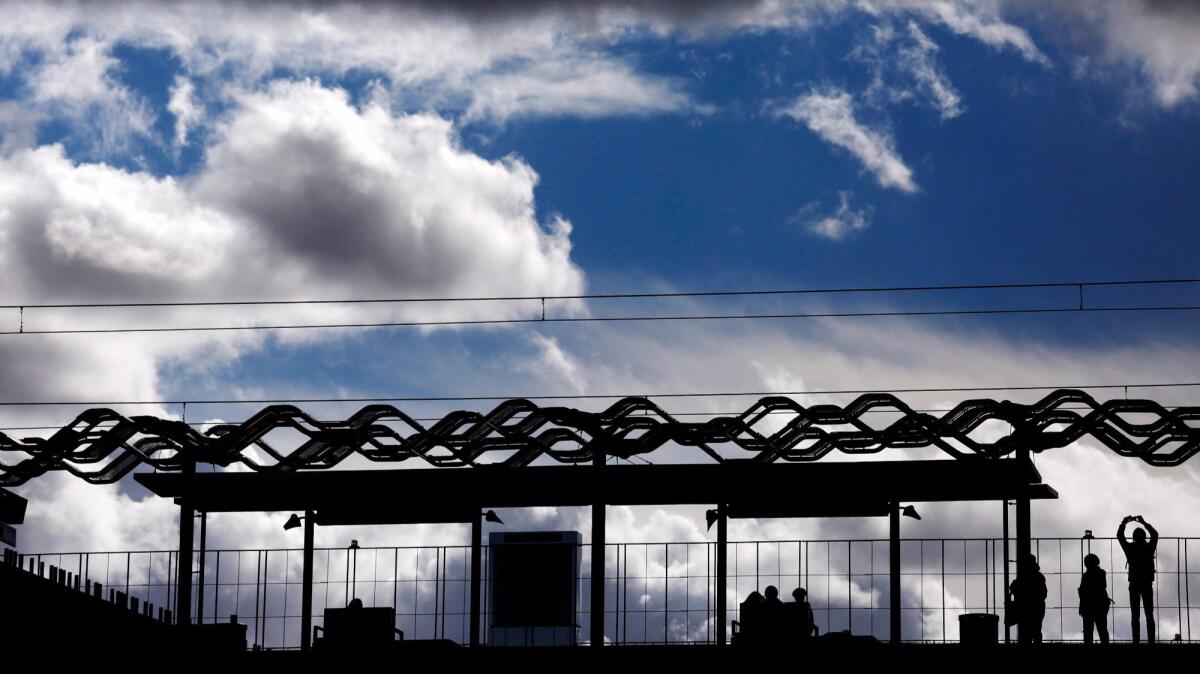L.A. weighs a plan to allow denser developments near Expo Line stations

Ridership on the $2-billion Expo Line has doubled since service began to the Westside 18 months ago, but the route would be an even better public investment if more Angelenos lived and worked near Metro stations, Los Angeles officials say.
A plan slowly moving through City Hall aims to address that goal by allowing denser commercial and residential buildings within a half-mile of five Expo Line stations between Culver City and Santa Monica.
The proposal could add 14,300 jobs, 6,000 new apartments and condos, and more pedestrian-friendly blocks along major corridors, city analysts say. Access to a rapid transit line, the thinking goes, would help residents run errands and get to work without getting behind the wheel.
But the Expo Line proposal has sparked a now-familiar debate over development in Los Angeles. Soon, the City Council will be forced to weigh advocates’ calls for more housing amid Los Angeles County’s housing affordability crisis against the preferences of neighborhood groups and elected officials — including Councilman Paul Koretz — who say the city cannot support more density.
The Exposition Corridor Transit Neighborhood Plan would rezone about 250 acres of West Los Angeles. Planning officials considered changes to about 2,000 acres, but left 87% of the area — including most single-family neighborhoods — unchanged.
Instead, officials focused on adding bigger buildings to major corridors — including Venice, Pico and Olympic boulevards — to accommodate more office buildings, condos, apartments and shops within blocks of five Metro stations.
“What we’re trying to do is un-gridlock the city by creating different housing options around mass transit,” city Planning Commission President David Ambroz said at a recent meeting.
Some areas, including more than a dozen blocks near the Bundy station, could be converted from traditional industrial zoning to what city planners call a “hybrid industrial” zone. The policy would encourage developers to reuse existing buildings and add new ones that would provide office space and some housing for the clean technology, creative and media industries.
“Those jobs are located in Culver City and Santa Monica right now,” said Patricia Diefenderfer, a senior city planner. “The city of L.A. hasn’t captured as many of those jobs as we probably could.”
The congestion on the Westside is partly caused by the lack of housing nearby, forcing commuters to travel long distances to work, said Westside Councilman Mike Bonin. Zoning near the Bundy station, which is in his district, should address that imbalance by offering more housing and fewer job sites, he said.
“I want to strike a sensitive balance between the public policy needs for more housing, and preserving the neighborhood feel,” Bonin said. “You’ve got some folks who don’t want to see any change, and you’ve got some folks who are part of the pro-density movement who are pushing for the sky’s the limit.”
The adjoining council district has taken a harder line. Koretz told the Planning Commission this month that the areas surrounding three Expo Line stations in his district “simply cannot support” more density without improvements to streets and other public infrastructure.
It’s a view shared by advocates from Fix the City, a group that has previously sued Los Angeles over development in Hollywood and has challenged the city’s sweeping transportation plan that calls for hundreds of bicycle- and bus-only lanes by 2035.
“It’s like when you buy a new appliance, you’d better read the fine print,” said Laura Lake, a Westwood resident and Fix the City board member. “This is not addressing the problems that it claims to be addressing.”
The Expo Line plan provides primarily market-rate housing and will do little to address the city’s housing affordability crisis, Lake said. Allowing more density is “growth inducing,” she said, and will exacerbate traffic on the Westside.
Fix the City has not decided whether to challenge the Expo proposal. The group does support some aspects of it, including design standards for new buildings, Lake said. But they are “window dressing for a plan that is making life harder for the people here,” she said.
The zoning plan and the city’s transportation plan, Mobility 2035, could reduce the number of miles driven per person in the project area by 3.1% over the next two decades, city analysts say — but congestion is expected to grow overall.
Rather than relying on the Expo Line plan to provide affordable housing, Lake said, Los Angeles should ban short-term rentals through companies such as Airbnb and work to provide incentives to developers to build denser housing within the current zoning laws.
Housing advocates, in contrast, have criticized city planners for not allowing denser zoning that could spur more construction.
Adding 6,000 units over two decades is a drop in the bucket for the region’s housing crisis, they say, and the city should be working to add as many units as possible near rapid transit.
“Most of Los Angeles is not going to change,” said Brent Gaisford, the director of the advocacy group Abundant Housing L.A. “We’re not telling you that you can’t live in a single-family home. We’re just asking you not to tell us that we can’t live in apartments.”
For more transportation news, follow @laura_nelson on Twitter.
More to Read
Sign up for Essential California
The most important California stories and recommendations in your inbox every morning.
You may occasionally receive promotional content from the Los Angeles Times.











